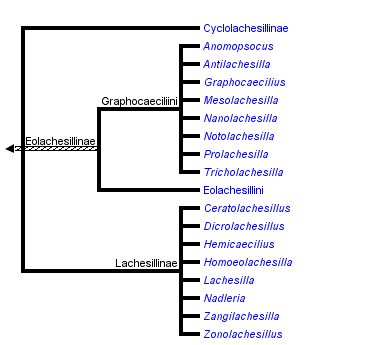Lachesillidae
Emilie Bess and Kevin P. Johnson


This tree diagram shows the relationships between several groups of organisms.
The root of the current tree connects the organisms featured in this tree to their containing group and the rest of the Tree of Life. The basal branching point in the tree represents the ancestor of the other groups in the tree. This ancestor diversified over time into several descendent subgroups, which are represented as internal nodes and terminal taxa to the right.

You can click on the root to travel down the Tree of Life all the way to the root of all Life, and you can click on the names of descendent subgroups to travel up the Tree of Life all the way to individual species.
For more information on ToL tree formatting, please see Interpreting the Tree or Classification. To learn more about phylogenetic trees, please visit our Phylogenetic Biology pages.
close boxIntroduction
The family Lachesillidae contains more than 270 species in 20 genera distributed worldwide, with the greatest diversity in Central and South America. About 50 species are known from North America, most in the genus Lachesilla.
These are medium-sized bark lice (adults 2-4 mm, nymphs 2-2.5 mm) with somewhat slender bodies. Body colors are brown; wings are usually clear, with or without markings. Lachesillids inhabit dead leaves, bark, grasses, foliage of conifers, and may also be found in stored food.
Characteristics
Synapomorphies
Lachesilliade (excluding genus Eolachesilla) is strongly supported by:
- Female:
- reduction of the dorsal valve of the gonapophyses
- absence of the ventral valve of the gonapophyses
General Characters
- Head: Antennae have 13 segments.
- Leg: Tarsi have 2 segments.
- Wings:
- Forewing veins have "Caecillius" pattern:
- Areola postica is free of vein M.
- Veins Rs and M are usually fused for part of their length.
- Forewings have sparse hairs or no hairs.
- Hindwings are hairless.
- Hindwing veins Rs and M are joined by relatively long fusion.
- Males:
- Phallosome is usually open and Y-shaped, sometimes a closed frame.
- Paraproct, epiproct, and hypandrium often have hooks or other processes.
- Female:
- Subgenital plate has one or two lobes.
- Gonapophyses are usually reduced to single external valve:
- Ventral valve is usually absent (present in Eolachesilla).
- Dorsal valve is reduced and has simple rounded apex.
- External valve is hairy.
- Eggs: Eggs are ridged, laid singly, and are not covered.
How to Know the Family
- Slender, medium-sized bark lice: 2-4 mm.
- Tarsi have 3 segments.
- Forewings are hairless or with sparse hairs.
- Forewing areola postica is free from vein M.
- Hindwings are hairless.
- Female: gonapophyses have reduced dorsal valve and lacking ventral valve.
Discussion of Phylogenetic Relationships
The subfamily and tribal relationships within Lachesillidae were established by Mockford and Sullivan (1986), and subsequent molecular studies have supported these relationships, with a few exceptions. The position of genus Eolachesilla (Eolachesillini) has been in question for a long time; molecular data show that it is more closely related to Elipsocidae (Johnson and Mockford 2003), and morphological data suggest that Eolachesilla may represent a separate family (Yoshizawa 2002).
The family Lachesillidae is closely associated with both Ectopsocidae and Caeciliusidae. A study of 18S nDNA, and 12S, 16S, COI mtDNA (Johnson and Mockford 2003) found one species of Lachesilla is sister to Ectopsocus (Ectopsocidae), and a second study of 18S found 4 species of Lachesilla to be monophyletic and sister to the subfamily Caeciliusetae (Johnson et al. 2004).
References
Johnson, K. P. & E. L. Mockford. 2003. Molecular Systematics of Psocomorpha (Psocoptera). Systematic Entomology 28: 409-40.
Johnson, K. P., K. Yoshizawa, and V. S. Smith. 2004. Multiple origins of parasitism in lice. Proceedings of the Royal Society of London B 271:1771-1776.
Lienhard, C. and C. N Smithers. 2002. Psocoptera (Insecta) World Catalogue and Bibliography. Muséum d'Histoire Naturelle, Geneva, Switzerland.
Mockford, E. L. 1993. North American Psocoptera (Insecta). Gainesville, Florida: Sandhill Crane Press.
Mockford, E.L. & Sullivan, D.M. 1986. Systematics of the Graphocaeciliine Psocids with a proposed higher classification of the family Lachesillidae (Psocoptera). Transactions of the American Entomological Society 112: 1–80.
New, T.R. 2005. Psocids, Psocoptera (Booklice and barklice), 2nd edition: Handbooks for the Identification of British Insects. Vol. 1, Part 7. Royal Entomological Society, London, UK.
Smithers, C. N. 1996. Psocoptera. Pp. 1-80, 363-372 (Index) in Wells A. (ed.) Zoological Catalogue of Australia. Vol. 26. Psocoptera, Phthiraptera, Thysanoptera. Melbourne: CSIRO Publishing, Australia.
Yoshizawa, K. 2002. Phylogeny and higher classification of suborder Psocomorpha (Insecta: Psocodea:'Psocoptera'). Zoological Journal of the Linnean Society 136: 371-400.
About This Page
Emilie Bess

Illinois Natural History Survey, Champaign, Illinois, USA
Kevin P. Johnson

Illinois Natural History Survey, Champaign, Illinois, USA
Correspondence regarding this page should be directed to Emilie Bess at and Kevin P. Johnson at
Page copyright © 2009 Emilie Bess and Kevin P. Johnson
All Rights Reserved.
- First online 25 March 2009
- Content changed 25 March 2009
Citing this page:
Bess, Emilie and Kevin P. Johnson. 2009. Lachesillidae. Version 25 March 2009 (under construction). http://tolweb.org/Lachesillidae/14471/2009.03.25 in The Tree of Life Web Project, http://tolweb.org/





 Go to quick links
Go to quick search
Go to navigation for this section of the ToL site
Go to detailed links for the ToL site
Go to quick links
Go to quick search
Go to navigation for this section of the ToL site
Go to detailed links for the ToL site